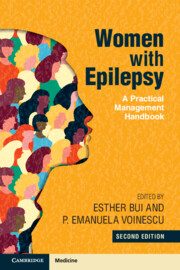Book contents
- Women with Epilepsy
- Women with Epilepsy
- Copyright page
- Epigraph
- Contents
- Contributors
- Chapter 1 Epidemiology of Women with Epilepsy
- Chapter 2 Neuropsychiatric Issues for Women with Epilepsy
- Chapter 3 Sleep-Related Comorbidities in Women with Epilepsy
- Chapter 4 Hormonal Influences in Women with Epilepsy
- Chapter 5 Antiseizure Medications and Hormones
- Chapter 6 Genetic Epilepsies in Females
- Chapter 7 Gender Issues in Childhood- and Adolescence-Onset Epilepsies
- Chapter 8 Catamenial Epilepsy
- Chapter 9 Fertility in Women with Epilepsy
- Chapter 10 Contraception and Prepregnancy Counseling
- Chapter 11 Teratogenicity and Antiseizure Medications
- Chapter 12 Seizure Management in Pregnancy
- Chapter 13 Obstetric and Fetal Monitoring in Women with Epilepsy
- Chapter 14 Neuroimaging in Pregnancy and Epilepsy
- Chapter 15 Obstetrical Anesthesia
- Chapter 16 Postpartum Seizure Management and Safety Issues for Women with Epilepsy
- Chapter 17 Breastfeeding and Use of Antiseizure Medications
- Chapter 18 Management of the Neonate
- Chapter 19 Aging, Menopause, and Bone Health in Women with Epilepsy
- Index
- References
Chapter 13 - Obstetric and Fetal Monitoring in Women with Epilepsy
Published online by Cambridge University Press: 19 December 2024
- Women with Epilepsy
- Women with Epilepsy
- Copyright page
- Epigraph
- Contents
- Contributors
- Chapter 1 Epidemiology of Women with Epilepsy
- Chapter 2 Neuropsychiatric Issues for Women with Epilepsy
- Chapter 3 Sleep-Related Comorbidities in Women with Epilepsy
- Chapter 4 Hormonal Influences in Women with Epilepsy
- Chapter 5 Antiseizure Medications and Hormones
- Chapter 6 Genetic Epilepsies in Females
- Chapter 7 Gender Issues in Childhood- and Adolescence-Onset Epilepsies
- Chapter 8 Catamenial Epilepsy
- Chapter 9 Fertility in Women with Epilepsy
- Chapter 10 Contraception and Prepregnancy Counseling
- Chapter 11 Teratogenicity and Antiseizure Medications
- Chapter 12 Seizure Management in Pregnancy
- Chapter 13 Obstetric and Fetal Monitoring in Women with Epilepsy
- Chapter 14 Neuroimaging in Pregnancy and Epilepsy
- Chapter 15 Obstetrical Anesthesia
- Chapter 16 Postpartum Seizure Management and Safety Issues for Women with Epilepsy
- Chapter 17 Breastfeeding and Use of Antiseizure Medications
- Chapter 18 Management of the Neonate
- Chapter 19 Aging, Menopause, and Bone Health in Women with Epilepsy
- Index
- References
Summary
Most women with epilepsy (WWE) will experience stable seizure control during pregnancy. Adverse fetal outcomes with epilepsy include spontaneous abortion, preterm birth, fetal growth restriction, major congenital malformation (MCM), hypertensive disorders of pregnancy, postpartum hemorrhage, peripartum depression, and—rarely—maternal death. Studies reporting these increased risks may be biased by differences in preexisting medical conditions, other patient characteristics, and anti-seizure medication (ASM) use and type. Poor seizure control preceding pregnancy, unplanned pregnancy, and polytherapy are associated with higher risks. Antenatal care should be coordinated by an experienced multidisciplinary team. Monotherapy with an appropriate ASM at the lowest effective dose is the goal, and drug levels should be monitored. Second trimester fetal anatomical sonography is the best screening modality for neural tube defects and other MCMs. Serial third trimester fetal growth ultrasounds are recommended. WWE are likely to have an uncomplicated labour and delivery. Epilepsy is not an indication for induction of labour or caesarean delivery. The risk of intrapartum seizures is 2−3%, and intractable seizures necessitating urgent delivery are rare. Attention is needed to avoid dehydration, missed ASM doses, sleep deprivation, and pain during labour and postpartum. WWE should be screened and counselled regarding their heightened risk of peripartum depression.
Keywords
- Type
- Chapter
- Information
- Women with EpilepsyA Practical Management Handbook, pp. 231 - 240Publisher: Cambridge University PressPrint publication year: 2025

